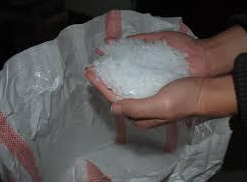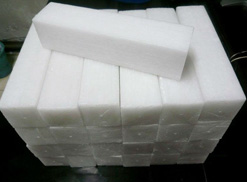
Paraffin Wax


Colourless or white, somewhat translucent, hard wax consisting of a mixture of solid straightchain hydrocarbons ranging in melting point from about 48° to 66° C (120° to 150° F). Paraffin wax is obtained from petroleum by dewaxing light lubricating oil stocks. It is used in candles, wax paper, polishes, cosmetics, and electrical insulators. It assists in extracting perfumes from flowers, forms a base for medical ointments, and supplies a waterproof coating for wood. In wood and paper matches, it helps to ignite the matchstick by supplying an easily vaporized hydrocarbon fuel. When most people think of wax, in any form, the wax they generally think of is probably a paraffin wax. It is one of the most plentiful and multi-use waxes used today. A by-product of the crude oil refining process, in its raw form, it is a white, odorless, tasteless, "waxy" solid, with a typical melting point between about 110°F to 150°F, and while it's very inert, it burns really well.
Pretty much any type of candle can be made with paraffin wax. The melting point is the primary determinant of the type of candle you can make with it & Paraffin wax, classified as a chemical preservative, is widely used on fruits, vegetables, and candy to make them shiny and pretty as well as to retard moisture loss and spoilage. Waxes are made from vegetable oils, palm oil derivatives, and synthetic resins, as well as other materials. Some people, notably those who are allergic to aspirin, may be sensitive to many waxes, depending on their ingredients.
Paraffin wax was first produced commercially in 1867,
- Low melt point paraffin (less than 130°F) is used for container candles in jars, cups or glasses
- Medium melt point paraffin (130°F - 150°F) is used for candles that need to stand on their own - votives, pillars and other molded candles
- High melt point wax (greater than 150°F) is used for more special applications like hurricane candle shells, over dipping and other special candle making applications.
Features & Uses
- Fruits, Chocolates, Candy etc.. to make them Shiny and Fresh
- Paper Industries
- Making Match Sticks
- Candle Manufacturing
- Coatings for waxed paper or cloth
- Anti-caking agent, moisture repellent, and dust binding coatings for fertilizers
- Ink. Used as the basis for solid ink different color blocks of wax for thermal printers
- Thickening agent in many Paintballs, as used by Crayola
- Used In Blending Of The Other Petroleum And Jelly Products & Many More...
Paraffin Wax Properties
While wax comes from many sources, it shares these common properties:
- Solid at ambient temperature
- Liquid at higher temperatures, characterized by melting points
- Insoluble in water, repels water
Packing
In Cartons Only

